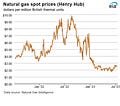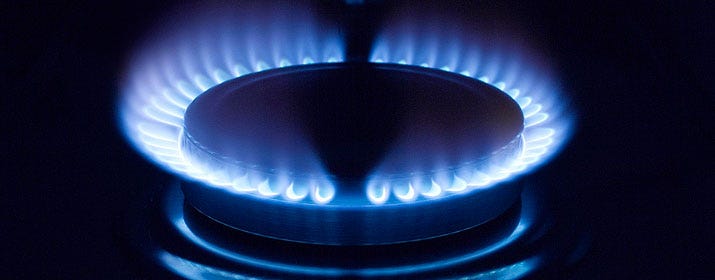Natural Gas Deliveries to U.S. LNG Export Facilities Increased in the First Half of 2023
Natural gas deliveries by pipeline to U.S. liquefied natural gas (LNG) export facilities (LNG feed gas) averaged 12.8 billion cubic feet per day (Bcf/d) in the first six months of 2023, following the Freeport LNG terminal’s return to service, according to data by S&P Global Commodity Insights. This average was 1.0 Bcf/d (8%) more than the 2022 annual average and 0.5 Bcf/d (4%) more than the same six-month period in 2022.
LNG feed gas set a monthly record in April 2023 at 14.0 Bcf/d, supported by high international demand for U.S. LNG exports, particularly in Europe. However, LNG feed gas declined in May (13.0 Bcf/d) and June (11.5 Bcf/d), mostly due to maintenance at several U.S. LNG export facilities, including Sabine Pass and Cameron.
LNG feed gas levels are typically higher than LNG export levels because LNG export terminals consume some of the feed gas to operate on-site liquefaction equipment. All U.S. LNG export facilities, except Freeport LNG, have on-site natural gas-fired power plants to generate electricity required to operate equipment involved in converting natural gas from a gaseous to a liquid state, or LNG.
We estimate that approximately 14% of LNG feed gas is used for liquefaction processes, mostly for on-site power generation. We capture the differences in LNG feed gas and LNG export levels under the Pipeline & Distribution Use category in our Natural Gas Monthly.
In addition to LNG feed gas used during the liquefaction process at LNG facilities, the Pipeline & Distribution Use category also includes natural gas consumed in pipeline transportation. In our Short-Term Energy Outlook (STEO), we account for feed gas used in the liquefaction process and natural gas consumed in pipeline transportation in the Natural Gas Pipeline and Distribution Use category in Table 5a. U.S. Natural Gas Supply, Consumption, and Inventories.
Freeport LNG is the only liquefaction facility in the United States and one of only two LNG export facilities in the world that uses electric motors exclusively instead of natural gas turbines to drive the liquefaction compressors.
Using electric motors helps the facility comply with the local air emission standards around the Houston area—the location of Freeport LNG. Freeport LNG purchases electricity from the grid to power its liquefaction processes because it does not have an on-site natural gas-fired power plant. As a result, most of Freeport LNG’s feed gas is converted into LNG.
We forecast U.S. LNG exports to average 12.0 Bcf/d in 2023 and 13.3 Bcf/d in 2024, as two new LNG liquefaction projects are expected to come online—Golden Pass and Plaquemines, according to our July 2023 STEO. Global economic conditions and demand for natural gas in Europe and Asia may affect our forecast.
Trends supporting higher LNG exports from the United States include assumed continuous replacement of Russia's natural gas exports by pipeline to Europe. Limited growth in global LNG export capacity in the next two years may increase the need for destination-flexible LNG supplies, mainly from the United States.
So far this year, mild winter temperatures and above-average storage inventories in the northern hemisphere decreased spot LNG prices, which could be an incentive to import more LNG, particularly in the relatively more price-sensitive countries of Southeast Asia.
For more information on a forecast of U.S. LNG exports, refer to our recently released STEO Between the Lines report.
On September 18, 2023 The Crude Life will host it’s Fourth Annual Podcast Party at the Energy Exposition being held in Jackson Hole, Wyoming. This year, three energy producing state governors will be joining us.
The Energy Exposition has educated tens of thousands of people in Gillette, Wyoming; Billings, Montana, and Loveland, Colorado, over the last 20 years on procedures, technology, safety, environmental practices, and equipment used in the oil and gas industry.
Exhibitors and Symposiasts represent a wide range of services, including but not limited to, exploration, production, downstream, and all phases of support to the oil and gas industry.
Energy Producing states Alaska Governor Mike Dunleavy, Oklahoma Governor Kevin Stitt and Wyoming Governor Mark Gordon will be attending this year’s expo and kick-off party.
To reserve Exhibit Space contact
Austin Jennings
239-898-3923
austin@energyexposition.com
For discounts and a special gift, use promo code OTIS
This Week’s Market Highlights: (For the week ending Wednesday, July 12, 2023)
Prices
Henry Hub spot price: The Henry Hub spot price fell 9 cents from $2.64 per million British thermal units (MMBtu) last Wednesday to $2.55/MMBtu yesterday.
Henry Hub futures prices: The price of the August 2023 NYMEX contract decreased 2.5 cents, from $2.657/MMBtu last Wednesday to $2.632/MMBtu yesterday. The price of the 12-month strip averaging August 2023 through July 2024 futures contracts declined 2.8 cents to $3.181/MMBtu.
Select regional spot prices: Natural gas spot price changes were mixed at major pricing hubs this report week (Wednesday, July 5, to Wednesday, July 12). Price changes ranged from a decrease of $6.06/MMBtu at Algonquin Citygate to an increase of $0.63/MMBtu at Tennessee Zone 4 Marcellus.
At the Algonquin Citygate, which serves Boston-area consumers, the price went down $6.06 from $7.93/MMBtu last Wednesday to $1.87/MMBtu yesterday, returning to levels more in line with other prices in the region. Algonquin Gas Transmission completed maintenance on Sunday that resulted in increased natural gas flows into New England. In addition, Units 2 and 3 of Millstone Power Station, a 2,108 MW-nuclear power plant in Waterford, Connecticut, resumed operating at full capacity as of July 6, after being offline for much of June, reducing demand for natural gas-fired generation. At the Transcontinental Pipeline Zone 6 trading point for New York City, the price decreased 8 cents from $1.87/MMBtu last Wednesday to $1.79/MMBtu yesterday.
In the Appalachian production region, spot prices rose. The Tennessee Zone 4 Marcellus spot price increased 63 cents from $0.92/MMBtu last Wednesday—the fifth time this year the price fell below $1.00/MMBtu—to $1.55/MMBtu yesterday. The price at Eastern Gas South in southwest Pennsylvania increased 20 cents from $1.44/MMBtu last Wednesday to $1.64/MMBtu yesterday. Natural gas flows from Appalachia to New York and New Jersey increased 7%, or 0.5 billion cubic feet per day (Bcf/d) week over week, according to data from S&P Global Commodity Insights. Temperatures in the New York-Central Park Area averaged 80°F this week, resulting in 16 more cooling degree days (CDDs) than last week and 22 more CDDs than normal.
Prices increased in most West Coast markets this week, except at SoCal Citygate in Southern California, where the price decreased 45 cents from $3.85/MMBtu last Wednesday to $3.40/MMBtu yesterday. Natural gas consumption in California declined 8% (0.4 Bcf/d) week over week, led by a 26% (0.5 Bcf/d) decrease in consumption in the electric power sector, according to data from S&P Global Commodity Insights. Temperatures in the Riverside Area, inland from Los Angeles, averaged 76°F this week, resulting in 3 fewer CDDs than last week and 11 fewer CDDs than normal. The share of natural gas used for power generation in California decreased from 42% last week to 36% this week, while the share of wind, solar, and hydroelectric power generation combined increased from 47% last week to 52% this week, according to our Hourly Electric Grid Monitor. The Southern California Gas Company’s (SoCalGas) natural gas storage stocks were almost 73 Bcf, very near the five-year (2018–2022) average, on July 13. The price in Northern California rose this week, along with other West Coast pricing hubs. At PG&E Citygate in Northern California, the price rose 36 cents, up from $3.96/MMBtu last Wednesday to $4.32/MMBtu yesterday.
In the Pacific Northwest, the price at Sumas on the Canada-Washington border rose 59 cents from $2.27/MMBtu last Wednesday to $2.86/MMBtu yesterday. At Malin, Oregon, the northern delivery point into the PG&E service territory, the price rose 25 cents from $2.63/MMBtu last Wednesday to $2.88/MMBtu yesterday. Capacity reductions occurred on the two major feeder lines from Canada into the Pacific Northwest. Gas Transmission Northwest declared force majeure due to unexpected equipment failure at its Starbuck compressor station in southeastern Washington, which reduced available capacity by approximately 0.4 Bcf/d at the Flow Past Kingsgate delivery point in Boundary, Idaho. On the Westcoast Energy Inc. pipeline, which delivers natural gas from British Columbia into Washington, available capacity was reduced by 0.5 Bcf/d on July 12.
International futures prices: International natural gas futures prices decreased this report week. According to Bloomberg Finance, L.P., weekly average front-month futures prices for liquefied natural gas (LNG) cargoes in East Asia decreased 9 cents to a weekly average of $12.04/MMBtu. Natural gas futures for delivery at the Title Transfer Facility (TTF) in the Netherlands decreased $1.43 to a weekly average of $9.78/MMBtu. In the same week last year (week ending July 13, 2022), the prices were $39.13/MMBtu in East Asia and $51.88/MMBtu at TTF. Forward prices were higher in East Asia compared with TTF for August–October as of July 12, according to Bloomberg Finance, L.P.
Natural gas plant liquids (NGPL) prices: The natural gas plant liquids composite price at Mont Belvieu, Texas, rose by 54 cents/MMBtu, averaging $6.25/MMBtu for the week ending July 12. Weekly average ethane prices rose 11%, while natural gas prices at the Houston Ship Channel rose by 1%, resulting in an increase of the ethane premium to natural gas by 27% week over week. Ethylene spot prices rose 2%, decreasing the ethylene to ethane premium by 7%. Propane prices rose 10%, while the Brent crude oil price rose 4%, decreasing the propane discount relative to crude oil by 1%. The normal butane price rose 10%, the isobutane price rose 8%, and the natural gasoline price rose 8%.
The Earth’s Champion Johnny Green (taking pic) is Cleanin’ and Johnny Greenin’ across America engaging with All Walks of Life.
The Greatest Environmentalist on Earth is spreading the word that “Renewables Ain’t Doable Without Fossil Fuelables”.
If you would like The Earth’s Champion Johnny Green and the 15-pounds of Eco-Authority to come to your event, school or town, contact The Crude Life for more info.
“All Energy Has A Purpose, And We Are All Energy,” Johnny Green reminds people of all ages.
Click here to read The Oilman Magazine’s feature on The Earth’s Champion Johnny Green
This Week in Supply and Demand
Supply: According to data from S&P Global Commodity Insights, the average total supply of natural gas fell by 0.5% (0.5 Bcf/d) compared with the previous report week. Dry natural gas production decreased by 0.1% (0.1 Bcf/d) to 101.8 Bcf/d, and average net imports from Canada decreased by 6.6% (0.4 Bcf/d) from last week to 5.5 Bcf/d.
Demand: Total U.S. consumption of natural gas fell by 2.2% (1.6 Bcf/d) compared with the previous report week, according to data from S&P Global Commodity Insights. Natural gas consumed for power generation declined by 2.8% (1.2 Bcf/d) week over week. Industrial sector consumption was essentially unchanged, and in the residential and commercial sectors, consumption declined by 4.1% (0.4 Bcf/d). Natural gas exports to Mexico decreased 1.5% (0.1 Bcf/d), and natural gas deliveries to U.S. LNG export facilities (LNG pipeline receipts) averaged 12.4 Bcf/d, or 0.4 Bcf/d lower than last week.
The Crude Life Daily Radio News & Lifestyle Update
Kunal Patel, Federal Reserve Bank of Dallas, shares the results of their latest oil and gas survey involving the 11th District, which includes the Permian, Haynesville, Eagleford and other smaller plays in TX, LA and NM. Supply Chain cost increases appear to be slowing down and production remains the same.
The Crude Life Daily Update has been running as a 3-minute news and lifestyle short on radio stations since 2011. In 2015 online podcast portals and news outlets were added to the list of distributors.
Expert interviews, news updates and multimedia crossovers available upon request.
If you have a news release, energy innovation, story idea, community lifestyle feature, guest, music band or show topic requests, email studio(at)thecrudelife(dot)com
Support the honest hard-working men, women and family who are living The Crude Life today!
About The Crude Life
Award winning interviewer and broadcast journalist Jason Spiess and a team of Content Correspondents engage with the industry’s best thinkers, writers, politicians, business leaders, scientists, entertainers, community leaders, cafe owners and other newsmakers in one-on-one interviews and round table discussions.
The Crude Life has been broadcasting on radio stations since 2011 and posts all updates and interviews on The Crude Life Social Media Network.
Everyday your story is being told by someone. Who is telling your story? Who are you telling your story to?
#thecrudelife promotes a culture of inclusion and respect through interviews, content creation, live events and partnerships that educate, enrich, and empower people to create a positive social environment for all, regardless of age, race, religion, sexual orientation, or physical or intellectual ability.
Spread the word. Support the industry. Share the energy.
Click on picture for BIG SAVINGS! Check out these Amazing American Environmental Entrepreneurs! Don’t forget that the promo code OTIS unlocks big big savings!
if link is broken, use promo code OTIS at www.mystore.com and www.mypillow.com

























Natural Gas, Dallas Fed Update, Supply Chain Costs Slow and Permian Production Stays Strong